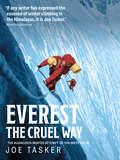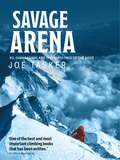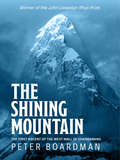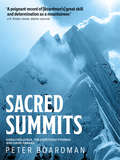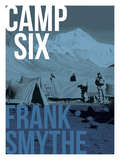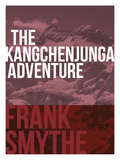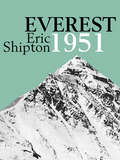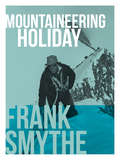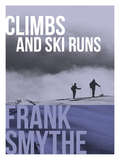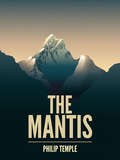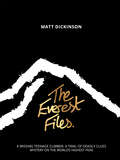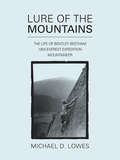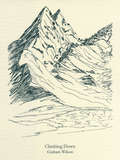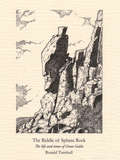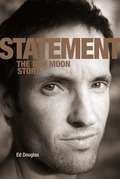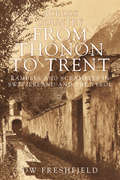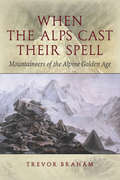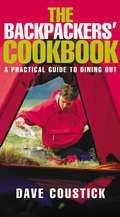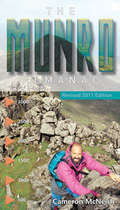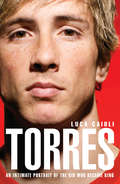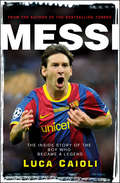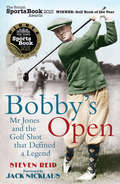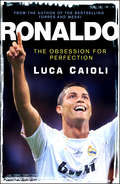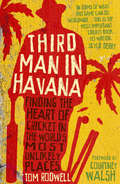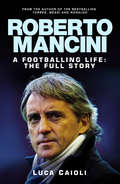- Table View
- List View
Everest the Cruel Way: Climbing Mount Everest at its hardest: the 1980 winter attempt on the infamous west ridge
by Joe TaskerOn 30 January 1981 Joe Tasker and Ade Burgess stood at 24,000 feet on the west ridge of Mount Everest. Below them were their companions, some exhausted, some crippled by illness, all virtually incapacitated. Further progress seemed impossible. Everest the Cruel Way is Joe Tasker's story of an attempt to climb the highest mountain on earth - an attempt which pushed a group of Britain's finest mountaineers to their limits. The goal had been to climb Mount Everest at its hardest: via the infamous west ridge, without supplementary oxygen and in winter. Tasker's epic account vividly describes experiences which no climber had previously endured. Close up and personal, it is a gripping account of day to day life on expedition and of the struggle to live at high altitude. Joe Tasker was one of Britain's best mountaineers. He was a pioneer of lightweight, Alpine-style climbing in the Greater Ranges and had a special talent for writing. He died, along with his friend Peter Boardman, high on Everest in 1982 while attempting a new and unclimbed line. Both men were superb mountaineers and talented writers.
Savage Arena: K2, Changabang and the North Face of the Eiger
by Joe TaskerI could never again maintain that I was caught up in this game unwillingly. I knew now what I wanted to do. Willingly would I accept the hardship and fear, the discipline and the sacrifices, if only I could be given back the chance to climb that mountain.' Joe Tasker lies, struck down by a tooth abscess, in a damp, bug-infested room in the Himalaya, wondering if he will be well enough to climb Dunagiri, his first venture to the 'big' mountains. He is there with Dick Renshaw to attempt to make a two-man ascent of the Peak - one of the first true Alpine-style expeditions to the Greater Ranges; an attempt that forms part of this tale of adventure in the savage vertical arena of hostile mountains. Joe Tasker was one of Britain's foremost mountaineers. A pioneer of lightweight mountaineering and a superbly gifted writer, in Savage Arena he vividly describes his participation in the first British winter ascent of the North Face of the Eiger; his first ascent of the West Wall of Changabang with Peter Boardman - considered to be a preposterous plan by the established climbing world; the first ascent of the North Ridge of Kangchenjunga; and his two unsuccessful attempts to climb K2, the second highest mountain in the world. This is a story of single-minded determination, strength and courage in a pursuit which owes much of its value and compulsion to the risks entailed - risks which often stimulate superlative performances. It is also a story of the stresses, strains and tensions of living in constant anxiety, often with only one other person, for long periods in which one is never far from moments of terror, and of the close and vital human relationships which spring from those circumstances. It is a moving, exciting and inspirational book about the adventuring spirit which seeks endless new climbing challenges to face, alluring problems to solve and difficulties to overcome, for it is not reaching the summit which is important, but the journey to it. Joe Tasker and Peter Boardman died on Everest in 1982, while attempting a new and unclimbed line. Both men were superb mountaineers and talented writers. Tasker's first book, Everest the Cruel Way, was first published in 1981. Savage Arena, his second book, was completed just before he left for Everest. Both books have become mountaineering classi. The literary legacy of Tasker and Boardman lives on through the Boardman Tasker Prize for Mountain Literature, established by family and friends in 1983 and presented annually to the author or co-authors of an original work which has made an outstanding contribution to mountain literature. For more information about the Boardman Tasker Prize, visit: www.boardmantasker.com 'The most riveting book on climbing that I have ever read.' Chris Bonington 'A gripping story of tremendous courage and unbelievable endurance.' Sir Edmund Hillary
The Shining Mountain: Two Men On Changabang's West Wall
by Peter Boardman'It's a preposterous plan. Still, if you do get up it, I think it'll be the hardest thing that's been done in the Himalayas.' So spoke Chris Bonington when Peter Boardman and Joe Tasker presented him with their plan to tackle the unclimbed West Wall of Changabang - the Shining Mountain - in 1976. Bonington's was one of the more positive responses; most felt the climb impossibly hard, especially for a two-man, lightweight expedition. This was, after all, perhaps the most fearsome and technically challenging granite wall in the Garhwal Himalaya and an ascent - particularly one in a lightweight style - would be more significant than anything done on Everest at the time. The idea had been Joe Tasker's. He had photographed the sheer, shining, white granite sweep of Changabang's West Wall on a previous expedition and asked Pete to return with him the following year. Tasker contributes a second voice throughout Boardman's story, which starts with acclimatisation, sleeping in a Salford frozen food store, and progresses through three nights of hell, marooned in hammocks during a storm, to moments of exultation at the variety and intricacy of the superb, if punishingly difficult, climbing. It is a story of how climbing a mountain can become an all-consuming goal, of the tensions inevitable in forty days of isolation on a two-man expedition; as well as a record of the moment of joy upon reaching the summit ridge against all odds. First published in 1978, The Shining Mountain is Peter Boardman's first book. It is a very personal and honest story that is also amusing, lucidly descriptive, very exciting, and never anything but immensely readable. It was awarded the John Llewelyn Rhys Prize for literature in 1979, winning wide acclaim. His second book, Sacred Summits, was published shortly after his death in 1982. Peter Boardman and Joe Tasker died on Everest in 1982, whilst attempting a new and unclimbed line. Both men were superb mountaineers and talented writers. Their literary legacy lives on through the Boardman Tasker Prize for Mountain Literature, established by family and friends in 1983 and presented annually to the author or co-authors of an original work which has made an outstanding contribution to mountain literature. For more information about the Boardman Tasker Prize, visit: www.boardmantasker.com
Sacred Summits: The Carstensz Pyramid, Kangchenjunga and Gauri Sankar
by Peter BoardmanMountaintops have long been seen as sacred places, home to gods and dreams. In one climbing year Peter Boardman visited three very different sacred mountains. He began on the South Face of the Carstensz Pyramid in New Guinea. This is the highest point between the Andes and the Himalaya, and one of the most inaccessible, rising above thick jungle inhabited by warring Stone Age tribes.During the spring Boardman made a four-man, oxygen-free attempt on the world's third highest peak, Kangchenjunga. Hurricane-force winds beat back their first two bids on the unclimbed North Ridge, but they eventually stood within feet of the summit – leaving the final few yards untrodden in deference to the inhabiting deity. In October, he climbed the mountain most sacred to the Sherpas: the twin-summited Gauri Sankar. Renowned for its technical difficulty and spectacular profile, it is aptly dubbed the Eiger of the Himalaya and Boardman's first ascent took a gruelling twenty-three days.Three sacred mountains, three very different expeditions, all superbly captured by Boardman in Sacred Summits, his second book, first published shortly after his death in 1982. Combining the excitement of extreme climbing with acute observation of life in the mountains, this is an amusing, dramatic, poignant and thought-provoking book.Peter Boardman and Joe Tasker died on Everest in 1982, whilst attempting a new and unclimbed line. Both men were superb mountaineers and talented writers. Their literary legacy lives on through the Boardman Tasker Prize for Mountain Literature, established by family and friends in 1983 and presented annually to the author or co-authors of an original work which has made an outstanding contribution to mountain literature.
Camp Six: The 1933 Everest Expedition
by Frank SmytheFrank Smythe's Camp Six is one of the greatest Everest accounts ever written. It is the story of the 1933 Everest Expedition, in which Smythe, climbing alone after his partner Eric Shipton had turned back ill, reached a point perhaps higher than any man had done before - and some twenty years before the eventual first ascent. Rope-less, oxygen free and in terrible snow conditions, his climb was one of the greatest endeavours in the history of Everest. Camp Six is a compelling read: a gripping adventure on the highest mountain in the world and a fascinating window into early mountaineering and Himalayan exploration - including an illuminating colonial view of early travels in Tibet. It is essential reading for all those interested in Everest and in the danger and drama of those early expeditions. Frank Smythe was one of the leading mountaineers of the twentieth century, an outstanding climber who, in his short life - he died aged forty-nine -was at the centre of high-altitude mountaineering development in its early years. Author of twenty-seven immensely popular books, he was an early example of the climber as celebrity.
The Kangchenjunga Adventure: The 1930 Expedition to the Third Highest Mountain in the World
by Frank SmytheWe went to Kangchenjunga in response not to the dictates of science, but in obedience to that indefinable urge men call adventure.' In 1930, an expedition set out to climb the world's third-highest mountain, Kangchenjunga. As yet unclimbed, a number of attempts had been made on the peak, including two in the previous year. The Kangchenjunga Adventure records Frank Smythe's attempts as part of an international team to reach the summit, how a deadly avalanche, which killed one of the sherpas, brought an end to their climb and how they turned their attentions instead to Jonsong Peak, which offered a more appealing alternative to risky assaults on the greatest peaks. Smythe's books from this period give compelling reads for anyone with an interest in mountaineering: riveting adventures on the highest peaks in the world, keen observations of the mountain landscape and a fascinating window into early mountaineering, colonial attitudes and Himalayan exploration. Smythe was one of the leading mountaineers of the twentieth century, an outstanding climber who, in his short life - he died aged forty-nine -was at the centre of high-altitude mountaineering development in its early years. He climbed extensively in the Alps, gained the summit of Kamet (the highest peak then climbed) in 1931 and, on the 1933 Everest Expedition, reached a point higher than ever before achieved. Author of twenty-seven immensely popular books, he was an early example of the climber as celebrity.
Everest 1951: The Mount Everest Reconnaissance Expedition (Eric Shipton: The Mountain Travel Books #1)
by Eric ShiptonIn 1953, Edmund Hillary and Tenzing Norgay reached the summit of Mount Everest. They climbed from the south, from Nepal, via the Khumbu Glacier - a route first pioneered in 1951 by a reconnaissance expedition led by Eric Shipton. Everest 1951 is the account of this expedition. It was the first to approach the mountain from the south side, it pioneered a route through the Khumbu icefall and it was the expedition on which Hillary set foot on Everest for the first time. Everest 1951 is a short but vitally important read for anybody with any interest in mountaineering or in Everest. The 1951 Everest Expedition marked the public highpoint of Shipton's mountaineering fame. Key information was discovered and the foundations laid for future success. Despite this, Shipton's critics felt he had a 'lack of trust' and thus failed to match the urgent mood of the period. Despite having been on more Everest expeditions than any man alive, he was 'eased' out of the crucial leadership role in 1953 and so missed the huge public acclaim given to Hillary, Tenzing Norgay and John Hunt after their historic success.
Mountaineering Holiday: An Outstanding Alpine Climbing Season, 1939
by Frank SmytheThere is no holiday like a mountaineering holiday. For eleven months the mountaineer has sighed for the mountain wind on his cheek, for the lilt of the mountain stream, for the feel of rock in his hand, for the crunch of frozen snow beneath his feet, for the smell of mist and the fragrance of alp and pine forest. 'In his spare moments he has read about mountains, pored over maps, and studied guidebooks. Then comes the day when he inspects his boots, his ice axe, and his rope. He packs his rucksack. He buys his railway ticket. The incredible has become credible. For two weeks, three weeks, or a month he will escape from civilisation and all its works; he is off to the mountains.' In Mountaineering Holiday, Frank Smythe records 'an outstanding Alpine climbing season' - his 1939 summer holiday Writing in his typically engaging style of keen observation, entertaining anecdote and remarkable knack for description, Smythe takes the reader with him on his trip into the Alps. Arriving unfit and out of practice, he gets stuck behind slower climbers and spends rainy days confined to the valleys before making an impressive number of successful ascents and historic climbs: Mont Tondu, the Aiguille de Bionnassay, the Brenva Face - and an ascent of the Innominata Ridge of Mont Blanc. There is a wonderful sense of familiarity about the book. Smythes's experiences and emotions are instantly recognisable by the modern climber, evoking memories of other trips and mountain days. And his examination of our need for mountains and wild places reaches conclusions that strike a chord with everybody who enjoys the great outdoors. Yet this is the 1930s. Mountaineering equipment and technique are in their infancy. Attitudes within climbing are markedly different to those of today and the first ascents of many major routes are still to be claimed. Europe is on the brink of war and fearful of the future. The book's final climb is made with four young Germans - mere days before World War II …
Climbs and Ski Runs
by Frank Smythe"Why do you climb?" The mountaineer has no answer to this question. The best things in the world cannot adequately be expressed in speech or print; they are part of the soul.' In Climbs and Ski Runs, Frank Smythe takes the reader on Alpine ski trips and Dolomite adventures, up first ascents in North Wales and on to the mighty Brenva Face of Mont Blanc. He places pebbles for runners, 'shoots' crevasses and is struck by lightning. And yet, all the while, he perfectly captures the moments that make climbing and mountaineering so special - moments that will resonate with anybody who has spent time in the hills. Frank Smythe was among the leading mountaineers of the early twentieth century and one of the finest climbing writers ever to put pen to paper. In Climbs and Ski Runs he documents his early forays into the mountains, giving a remarkable insight into that period of climbing and mountaineering. Yet it is not this that makes the book special. It is Smythe's ability to observe and recreate his surroundings and to write so compellingly about the climber's response to them, and to the moments of difficulty and danger, that brings Climbs and Ski Runs to life.
The Mantis: A mountaineering novel
by Philip TempleIt is not the courage to go back up that we need. It's the courage to go down. Just to go on … ' In 1977 a British expedition led by Himalayan veteran Geoff Strickland, summiteer of K2 and Everest among others, set off to attempt the first ascent of unclimbed Puthemojar - the 'Mantis' - in the Karakoram. 25,311 feet high, renowned for its difficulty, and with a fearsome reputation, the Mantis had claimed the life of at least one climber on each of the previous expeditions that had attempted to scale its complex series of ridges and icefalls. In order to claim the coveted first ascent, Strickland put together a small team comprising the cream of British mountaineering talent: his long-time Himalayan climbing partner and photographer Michael Blackmore; the redoubtable northerner Joe Dodge, as tough as they come; Dodge's regular partner and another veteran of numerous Himalayan expeditions Doug Lowrie; and two young guns - Brit Alan Wyllie, and Kiwi Peter Chase, a pair who had been tearing up the Alpine rule book with daring ascents on the steepest and most difficult faces. Although Michael Blackmore's 1980 record of the climb - The Last Challenge - has become a classic of mountaineering literature, Blackmore himself was never satisfied it told the full story of the events on Puthemojar in 1977. Before his death in 2000, Blackmore had prepared a draft manuscript - a 'creative narrative' - of the expedition which, with thanks to Blackmore's widow, has now been completed by award-winning author and mountaineer Philip Temple. While perhaps best regarded as a work of fiction, The Mantis tells for the first time the gripping story of that 1977 British expedition to Puthemojar. It is a portrait of these men, their drive, this mountain and a credible testimony of just what went on, high on the Mantis.
The Everest Files: A Deadly Earthquake In The Himalaya. A Climber Trapped High On Everest. An Epic Rescue Attempt Is About To Begin. (The Everest Files #1)
by Matt DickinsonA thrilling journey to the dark side of Everest. In the deepest Himalaya a story is spreading like wildfire. The story of an Everest expedition unlike any other. An expedition that ended in lies, betrayal, mysterious disappearances … and death. At the heart of it all - rumours of dark forces at play. This is the mystery that eighteen-year-old Ryan Hart sets out to solve. Ryan is on a gap year adventure, working for a medical charity in Nepal. In his own words he is 'up for anything' and when a local girl begs him to investigate why her sixteen-year-old friend Kami never came back from Everest, Ryan cannot resist the challenge. A solo journey takes Ryan deep into the mountains where his detective work finally pays off. What emerges is a shocking story of fatal human errors, a twisting tale in which life and death decisions are distorted by ambition, ego and greed. All played out on the lethal slopes of the highest mountain in the world. Kami's story seems like an open and shut case but something has changed in Ryan and it turns out the adventure isn't over. Everest is calling ... and Ryan may not be able to resist.
Lure of the Mountains: The life of Bentley Beetham, 1924 Everest Expedition Mountaineer
by Michael D. LowesLure of the Mountains is the first published biography of accomplished photographer, ornithologist, teacher and 1924 Everest expedition member Bentley Beetham (1886-1963). Written by the late Michael D. Lowes, a pupil of Beetham's at Barnard Castle School in County Durham, and with a foreword by Graham Ratcliffe MBE, the first Briton to have summited Everest from both the North and South sides, and also a pupil of Barnard Castle School. Lure of the Mountains charts Beetham's life from childhood in Darlington, to rock climbing in the Lake District, to his selection by the Mount Everest Committee as a member of the infamous and ill-fated 1924 Everest Expedition on which George Mallory and Sandy Irvine disappeared high on the mountain. Many of Beetham's images, including those made on the 1924 expedition, were for over 25 years curated by Michael Lowes and are reproduced in this book with the kind permission of the Bentley Beetham Trust and Durham University. His images of Tibet are 'an important historical record of Tibetan culture and a way of life that in modern times has rapidly begun to disappear'. Beetham was a highly skilled rock climber and a pioneer of new routes in the Borrowdale Valley, where he established such notable climbs as Little Chamonix on Shepherd's Crag, and Corvus on Raven Crag. The author, like many other pupils Beetham inspired, was introduced to climbing by his teacher in the Lake District on club trips, and over the years he became a valuable source of information and expert on Beetham's life and work.
Climbing Down: Long distance walks in the Scottish, Welsh and English hills in manageable chunks
by Graham WilsonGraham Wilson's Climbing Down, selected as a Travel Book of the Week in The Guardian, features long distance walks in the Scottish, Welsh and English hills — but in manageable chunks. Wilson makes an entertaining companion; once he was fit enough for the Bob Graham Round, now he's the victim of a crumbling hip. So, he breaks the walks into sections and, instead of calling on a shuttle-service of friends with cars, takes to public transport. The walks include an Alternative Snowdon Horseshoe, a Scottish Coast to Coast and the Yorkshire Centurion, as well as several Peak District rounds. And a new, gentler activity is proposed for the compulsive list-ticker: island-bagging. Wilson's experiences are recounted in his own inimitable style, with the usual eccentric digressions into topi such as coffin roads and cut-hopping, Munros and mobile phones, solo climbing and slippered pigs. Wonderfully illustrated with drawings by Gerry Dale.
The Riddle of Sphinx Rock: The life and times of Great Gable
by Ronald TurnbullGrand to look at, grand to look from, and grand to climb' - so Great Gable was described over a hundred years ago. Probably the Lake District's best loved hill, it receives twenty thousand ascents each year and has seen the birth of two separate sorts of hill sport. In The Riddle of Sphinx Rock, award-winning outdoor writer Ronald Turnbull asks why we find Great Gable so irresistibly attractive. His answer suggests that the greatness of Gable is far more than just a matter of getting to the top. As he walks, scrambles and climbs, he explores the subtleties of its terrain and its geology, history and myths. You'll meet characters and locations that are an integral part of its story: Wordsworth and his Wheel of Fells, Fanny Mercer and her bad alpenstock technique, the Wadd Holes and Pillar Rock, Moses Rigg and Geoffrey Winthrop Young. By turns intriguing and funny, erudite and provocative, The Riddle of Sphinx Rock was chosen by Trail magazine as one of six top titles in its How To Be Mountain Literate section: 'A boutique history of one the UK's most fascinating mountains, filled with memorable characters, classic routes and derring-do. Puts you in the historic thick of one of our most atmospheric and iconic mountains.'
Statement: The Ben Moon Story
by Ed DouglasOn 14 June 1990, at Raven Tor in the Derbyshire Peak District, twenty-four-year-old Ben Moon squeezed his feet into a pair of rock shoes, tied in to his rope, chalked his fingers and pulled on to the wickedly overhanging, zebra-striped wall of limestone. Two minutes later he had made rock-climbing history with the first ascent of Hubble, now widely recognised as the world's first F9a. Born in the suburbs of London in 1966, Moon started rock climbing on the sandstone outcrops of Kent and Sussex. A pioneer in the sport-climbing revolution of the 1980s and a bouldering legend in the 1990s, he is one of the most iconic rock climbers in the sport's history, In Statement, Moon's official biography, award-winning writer Ed Douglas paints a portrait of a climbing visionary and dispels the myth of Moon as an anti-traditional climbing renegade. Interviews with Moon are complemented with insights from family and friends and extracts from magazines and personal diaries and letters. 'Ever since I first set foot on rock at the tender age of seven years, climbing has been the most important thing in my life. In fact I would go so far as to say it is my reason for living and as long as I am able to climb I hope I will. It is from climbing I draw my inspiration for life.'
Across the Country from Thonon to Trent: Rambles and Scrambles in Switzerland and the Tyrol
by Douglas FreshfieldThis is a true 'Boys' Own' adventure story of how three English schoolboys spent the summer of 1863 trekking through the Swiss and Italian Alps before conquering Mont Blanc. It is an utterly unique journal written by one of that party who would go on the become one of the great mountain and travel writers of the Victorian era and make a huge contribution to the Royal Geographic Society and the Alpine Club. His name was Douglas William Freshfield. Douglas William Freshfield was born on Sunday, 27 April 1845 in London, the only son of Henry Ray Freshfield and Jane Quinton Crawford. After being educated at Eton College and University College, Oxford, he followed his father into the legal profession and was called to the bar in 1870. One of the features of his privileged childhood was the opportunity to travel with his parents and enjoy long summer holidays abroad. At the age of eight he had his first experience of the Swiss Alps undertaking a journey from Basel to Chamonix. Eventually, in 1863, he was ready to undertake an Alpine adventure of his own planning. This volume, which he arranged to have printed privately in 1865 was his first work of mountain literature and also his rarest. It is his journal of that trek made from the southern shores of Lake Geneva, in the company of two schoolfriends, through the Swiss Alps and into northern Italy during the summer of 1863. Freshfield was only 18 when he made the trip, and in the narrative of the journal can be found the beginnings of the style and observational genius that was to serve him well over the course of his writing career. The reader is engaged at once with the three young men as they begin their adventure and is bowled along as an unseen travelling companion through the high routes and passes, the valleys and gorges until making the summit with them on Mont Blanc. It is an engaging and informative journal of how privileged young Englishmen once spent their leisure time and reveals a lifestyle long gone now but still worthy of reminiscence.
When the Alps Cast Their Spell: Mountaineers of the Alpine Golden Age
by Trevor BrahamThe sport of mountaineering was pioneered 150 years ago by a diverse cross-section of Victorians, following in the footsteps of earlier local explorers who ventured into the upper regions of ice and snow in search of game and minerals. By the early years of the 19th century, a growing interest in the study of geological and glaciological phenomena attracted scientific interest in the origins of the Alps. It was only in the latter half of that century when, by the 1850s, interest in the largly unexplored Alpine peaks began to capture the public imagination, and a sharp increase developed in the numbers of those who tried to scale them. So intense was the level of exploration and achievement that the next decade was labelled the Alpine Golden Age. By the turn of the century the new sport had not only expanded vastly, but had begun to acquire a degree of respectability. The development of new skills and techniques resulted in greater accomplishments, whilst retaining the spirit and traditions of the pioneers. In this book the mountaineer and writer Trevor Braham illustrates aspects of the character and achievements of some of the early Victorian climbers, and their response to the unique attractions of mountaineering. These include Leslie Stephen (the father of Virginia Woolf), Alfred Wills, John Tyndall, Adolphus Warburton Moore, Edward Whymper (the first to conquer the Matterhorn), Albert Frederick Mummery and many more. Trevor Braham's comprehensive history on this period of Alpine mountaineering is essential to any mountaineer's bookshelf.
Backpacker's Cookbook: A Practical Guide To Dining Out
by Tristan Wood"Tristan Wood is a long-standing member of the Club Taurino of London, the foremost gathering of English-speaking aficionados, Tristan has edited the Club’s prestigious bi-monthly magazine, La Divisa, for the past eight years. In addition to writing on bullfighting, Tristan has published books on motor racing and on the changing role of men in a post-feminist world. He lives in London with his partner Sally."
Munro Almanac
by Cameron McNeishThis guide to all of Scotland's Munros details the new list of 285 peaks and their localities, Gaelic pronunciation, height, and climbing routes with times for both ascent and descent. Maps and photographs illustrate the region with hints on where to stay, OS references and difficulty ratings.
Torres: An Intimate Portrait of the Kid Who Became King
by Luca CaioliA brand new biography of Liverpool and Premier League superstar, Fernando Torres, based on one-of-a-kind insider interviews with those closest to him ... and the player himself. This is the story of a kid who wanted to be a rock star but who turned into a football god, the idolised and adopted son of 42 million Liverpool fans across the world. From his birth in Madrid through to his winning goal in Euro 2008 and beyond, the book goes ehind the scenes of Torres' life and career to examine what makes the golden boy of football tick as well as kick. Renowned sports journalist Luca Caioli has exclusively interviewed figures from fans to his father, Rafa Benítez to Luís Aragones, Steven Gerrard to Kenny Dalglish, Fabio Capello, and Fernando Torres himself. This unrivalled material will give the real untold story of how The Kid became the King of Europe...
Messi – 2013 Edition: The Inside Story of the Boy Who Became a Legend
by Luca CaioliEl Pibe de Oro. The Golden Boy. Diego Maradona’s unwaning shadow looms large over world football. In 2007 the brilliant Argentine chose Lionel Messi as his successor to the famous No. 10 shirt. But you can never be sure that potential will be fulfilled. Three years later, Messi – El Pulga, the Flea – is a European Champion, Olympic Gold Medallist, the most naturally gifted footballer on the planet and a hero to millions of fans across the globe. Champions, reporters and coaches blunder time and time again in their haste to find superstars. This time they got it right. Aged only 22, he shows a degree of maturity rarely seen on the soccer pitch. Yet underneath the layers of footballing brilliance, he is still the shy boy who describes his Maradona moment with disarming simplicity: ‘I saw the gap and I went for it.’ Transcending both club and country, he is a sporting god who prefers homemade cookies to brand name perfumes. Author Luca Caioli draws on exceptional testimonies. Messi’s parents, Celia and Jorge, his bother Rodrigo and his uncles and aunts; his coaches at Grandoli and Newell’s Old Boys; Charly Rexach, Alex García, Frank Rjikaard, Gianluca Zambrotta from Barcelona; Hugo Tocalli, Pancho Ferrero, el Coco Basile, Roberto Perfumo from Argentina. And to conclude, Leo Messi himself sizes up his life so far.
Bobby's Open: Mr Jones and the Golf Shot that Defined a Legend
by Steven ReidTIMES BRITISH SPORTS BOOK OF THE YEAR 2013 25th June 1926. Royal Lytham & St Annes Golf Club is hosting the world's oldest and most prestigious golf tournament - The Open Championship. A stellar field of players has assembled from both sides of the Atlantic hoping to claim victory, including Walter Hagen, Harry Vardon and a rising young amateur from the USA, Bobby Jones. Already a winner of the US Open and US Amateur Championship, Jones has yet to win a Major event on British soil. To do so now would set him on a path of unrivalled achievement and into the history books as the greatest amateur golfer the world has ever known. As the competition boils down to the penultimate hole on the final day, Bobby must hold his nerve to pull off a miracle recovery shot that will fire his reputation - and that of the golf course - around the world. Bobby's Open is the inspirational story of a golfing legend and one of the game's defining contests. Steven Reid blends social history with sporting biography to portray the most famous sportsman of his time, examining why Jones was so adored and the cruel price he ultimately paid for his genius.
Ronaldo – 2013 Edition: The Obsession for Perfection (Luca Caioli Ser.)
by Luca CaioliFrom the author of the bestselling Torres and Messi, a revealing new biography of Real Madrid’s Cristiano Ronaldo. When a young Portuguese player with sublime abilities arrived at Manchester United in 2003, Alex Ferguson put the no. 7 shirt – once worn by Best, Cantona and Beckham – on his back without hesitation. The expectation was clear, and Cristiano Ronaldo didn’t disappoint. Ronaldo won the FIFA World Footballer of the Year in 2008, the first Premier League player ever to do so. Since his record-breaking £80m move to Real Madrid, his goal-scoring flair has continued and made his on-going rivalry with Barcelona’s Lionel Messi even more intense. Luca Caioli tells the inside story of this global superstar both on and off the pitch, unveiling the life of one of modern football’s great players as never before.
Third Man in Havana: Finding the heart of cricket in the world's most unlikely places
by Tom RodwellWhen Tom Rodwell embarked on a cricketing tour of India, he had only ever thought of the game as great fun. But the simple joy of the local street kids when his team donated their kit to them made him realise that it could be more than that. By turns touching and amusing, and imbued with a deep love of the game, Third Man in Havana is the story of the charity cricket programmes ‘Major’ Tom Rodwell has helped run around the world, and of the people he has encountered along the way. From Be’er Sheva Cricket Club pavilion in Israel – a converted nuclear bomb shelter, useful in the face of Hamas’ regular rocket attacks – to a game of tapeball cricket with ex-Tamil Tiger child soldiers behind barbed wire in Sri Lanka, Rodwell discovered that the heart of the game is beating fast in countries more used to conflict than cricket. Third Man in Havana is a wonderfully positive story, revealing that the spirit of cricket is alive and well.
Roberto Mancini: A Footballing Life: The Full Story
by Luca CaioliWhen Manchester City’s owners appointed Roberto Mancini in late 2009, the message was clear: this was the man who would overtake the Blues’ illustrious neighbours and restore the club to the pinnacle of English football. The former Italy playmaker swiftly repaid their faith, following up an FA Cup triumph in his first full season with the Premier League title – won in the most heartstopping fashion imaginable – to continue a success story that had taken him from early stardom in Bologna to back-to-back league titles as Inter Milan manager. Now, renowned Italian sports writer Luca Caioli gives the full inside story of Mancini’s rollercoaster life in football – from his early days as a firebrand centre forward, through glory days with Sampdoria and Lazio, to his emergence as a charismatic, if controversial, pitch-side leader. Featuring insights from those who know him best – including family members, former teammates and managers, as well as an exclusive interview with Mancini himself, it provides a unique and revealing portrait of the man behind the Blue revolution.
